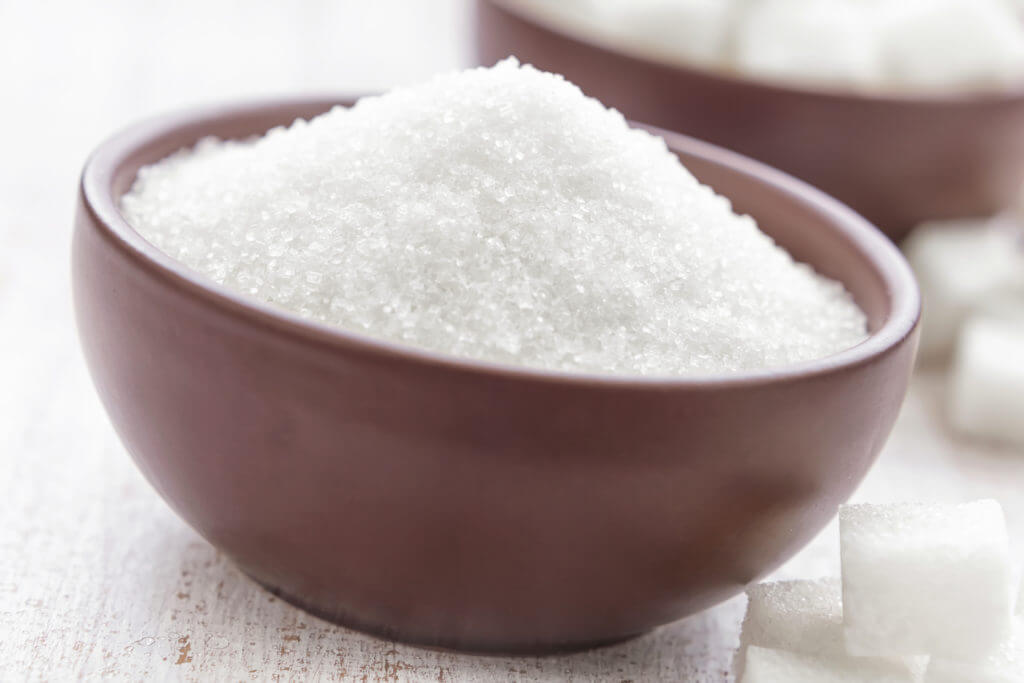Humans lose much of their ability to break down certain sugars as we mature into adults or experience intestinal infections. Many people malabsorb lactose and fructose, to some degree we all probably do. This unabsorbed sugar becomes food for opportunistic bacteria.

Below I will discuss mostly lactose (dairy sugar) and fructose (fruit sugar) malabsorption as these are by far the two most malabsorbed sugars. Malabsorbing either can cause SIBO, bloating, intestinal dysbiosis, and perhaps lead to IBS,
Lactose Malabsorption:
Though it varies from person to person, lactose intolerance is MUCH worse than doctors generally believe. When lactose (or almost any sugar) is not absorbed by the small intestine it goes on to feed bacteria, yeast, and archaea, plain and simple. If there are certain opportunistic, or pathogenic, bacteria present that is primarily what you’ll be feeding. When they’re “opportunistic” this is often what they’re waiting for – unabsorbed sugars to flow their way.
“Lactose -positive gram negative rods” may suggest Enterobacteriaceae, such as E. coli, Klebsiella, or Enterobacter spp. — mednet.ucla.edu
When a doctor does a lactose intolerance test they give you a lactose mixture to drink; then they look for hydrogen gas being released from the small intestine. Hydrogen gas production indicates the presence of certain unwanted bacterial strains. High hydrogen levels, after lactose administration, usually indicates a positive result for lactose intolerance. But a negative result simply means you don’t have hydrogen producing, lactose consuming, bacteria in your small intestine (yet), but these same strains can have an orgy in your colon and cause all sorts of problems later in the day. Doctors do not test for your body’s ability to produce the enzyme, lactase, that breaks down lactose into glucose (so the body can absorb and utilize it). Without this enzyme humans can not absorb and utilize lactose.
The following study shows how e.Coli prefers lactose over glucose and galactose. e.Coli will preferentially consume lactose over glucose and galactose, only consuming them after the lactose is used up.
“A typical batch culture using lactose as substrate is shown in Fig. 1. Three phases of hydrogen production can be noted (Fig. 1A). In the first 60 h, the hydrogen-specific production rate was 0.34 mmol H2/L h OD600 nm unit and, 980 mL were produced. In the following 35 h, the hydrogen production rate was 0.02 mmol H2/L h OD600 nm unit, and only 35 mL were produced. After 95 h and onwards, hydrogen was continuously produced reaching 2092 mL in 576 h. The maximum hydrogen production rate was 15.41 mL/L h. When lactose was consumed, galactose and glucose were accumulated.
Glucose reached a maximum of 3.2 g/L at 9 h and became undetectable after 34 h. The maximum galactose concentration was 7.45 g/L at 27 h, after which the concentration decreased to 1.2 g/L at the end of the experiment. Lactose was not detected after 12 h (Fig. 1B)” — doi:10.1016/j.biortech.2012.01.175
The earliest study I can find on this topic dates back to 1905, titled “Lactose-Fermenting Bacteria in Faeces”. It too studies Escherichia coli (called “Bacillus Coli” back then). We’ve known for a long time that certain bacteria prefer simple sugars (and disaccharides) more than other strains.
If someone has lactose intolerance they can consume lactase enzyme supplements (such as LactAid) to help break down the lactose in the dairy food they’re eating. However, these supplements are not usually 100% effective, especially if someone has rapid digestion transit times (food moves through the small intestine too rapidly). You can improve the effectiveness of these supplements by doing the following;
- consume the food with lactose as a dessert immediately after a meal. This will slow transit time so the lactose containing food stays in the small intestine longer.
- take 3 times the recommended dose
- divide this dose as follows, take 1/3rd with the first bite of the lactose containing food, 1/3rd half way through, 1/3rd immediately after finishing
- consume in moderation!
This will give you the best chance of the lactase breaking down most of the lactose sugar molecules. Another tip is to consume only hard and aged cheeses, and other well fermented dairy products. These have had the lactose consumed by the bacteria used in the fermentation. Most restaurants are happy to substitute Swiss cheese (a very low lactose cheese) for American cheese (very high in lactose).
Fructose Malabsorption:
Humans aren’t born with an enzyme in the gut to break down fructose and convert it to glucose. Instead we have “transport molecules” (GLUT5 is the primary one). This molecule attaches to the fructose and transports it through the wall of the small intestine. Once there the fructose is in the blood and goes to the liver for processing into glucose (eating too much fructose is one of the causes of non alcoholic fatty liver disease). This process, however, is not very efficient. In healthy people there is a limited supply of GLUT5, enough to transport between 25-50 grams of fructose (it varies from person to person). A person is defined as having fructose malabsorption issues if they can not process 25 grams of fructose in one sitting.
“According to the US Department of Agriculture (USDA), HFCS consumption has increased for more than 1000% between 1970 and 1990 [5], with an annual consumption of fructose to have risen from less than a ton in 1966 to 8.8 million tons in 2003… It is important to consider small intestinal bacterial overgrowth (SIBO) as a cause for unexplained GI symptoms, and especially when breath tests for hydrogen (H2) and methane (CH4) are positive with glucose and fructose” — PubMed ID#PMC3934501
There is also a condition called “hereditary fructose intolerance” where the liver does not make the enzyme to break down fructose. If one has this condition they are normally born with it. In this condition GLUT5 transports the fructose from the small intestine, but the liver isn’t doing its job. This is a potentially fatal condition and is not discussed in this article or in The Gut Health Protocol book.
If you don’t have enough GLUT5 the fructose doesn’t get absorbed and it goes on to feed bacteria. In the beginning of this condition a person may have so much good bacteria that it is consuming the fructose and few symptoms are noticed. But over time all of this unabsorbed sugar throws off the microbial balance and the bad guys start to take over. This opportunistic bacteria often migrates from the colon, translocating further and further up the small intestine. If you have had to take antibiotics that can speed up this degenerative process, as it can wipe out the good microbes that normally help protect our guts from infection.
Can fructose malabsorption be fixed? That depends. If you were born with an inability to manufacturer GLUT5 then no, it probably can’t be fixed. If this condition started after a bout of SIBO, food poisoning, or a reaction to medications, then maybe. The cells that manufacture GLUT5 can be damaged by toxins (including those from bacteria). Once the infections are cleared some of these cells may regenerate. This was very much the case with me. I was very much fructose intolerant, I can not tolerate fructans (a fiber made of fructose molecules) and small amounts of pure fructose.
There is also an enzyme supplement that can help, its called xylose isomerase. It doesn’t naturally exist in the human body, but it can be taken as a supplement. It breaks down fructose and converts it to glucose in the intestine. It isn’t perfect, but it does help.
“The dietary recommendation to avoid or at least to reduce the amount of fructose within the diet appears logical for IBS patients with a demonstrated symptomatic fructose malabsorption associated with the onset of intestinal symptoms after fructose intake… our study demonstrates that the prevalence of symptomatic malabsorption of a 25 g fructose load was 22% in IBS patients” — PubMed ID#PMC4040818
Fructose bound to glucose (e.g. in table sugar / sucrose) can be transported through the intestine riding on glucose. For every molecule of fructose, one molecule of glucose must be bound to it. This is why sucrose is less of a problem for people with true fructose malabsorption (sucrose is fructose and glucose bound together in a 1 to 1 ratio). Adding glucose (dextrose) to a meal doesn’t help, the molecules have to be bound together.
A positive lactulose breath test was found in 64 of 98 (65%) (IBS) subjects; these small intestinal bacterial overgrowth patients showed a significantly higher prevalence of positivity to the lactose breath test (P < 0.05), fructose breath test (P < 0.01) and sorbitol breath test (P < 0.01) when compared with the small intestinal bacterial overgrowth-negatives. — PubMed ID#15932370
Glucose Malabsoprtion:
This a fairly rare condition, and one that normally is diagnosed very early in life. Because disaccharides, such as sucrose (table sugar) and lactose (milk sugar) are broken down, or converted, in to glucose during digestion, they too will not be absorbed. This can be a life threatening condition for infants if not caught early. As many as 10 percent of the population may have a somewhat reduced capacity for glucose absorption; however, these people may will not have all of the associated health problems. This condition is most likely a milder variation of glucose-galactose malabsorption. This is a condition that should be diagnosed and treated by a physician. See the following NIH.GOV article for more information.
Repairing / rebalancing the microbiome can help with symptoms from most of these conditions. You will still have the malabsorption, but without bad bacteria feeding on it you’ll notice far fewer symptoms. However, this should not be abused as consuming too much of the malabsorbed sugar will eventually lead to a bad bacteria overgrowth. Avoidance is the best policy. Most adults should assume they have some level of both lactose and fructose malabsorption, especially if they have SIBO. If you don’t have SIBO watch for any change in symptoms, mode, and feeling of well being, 8-24 hours after consuming these sugars; any changes can denote opportunistic bacteria in the colon feeding on the unabsorbed sugars.
All images posted by John Herron are either "Copyrighted John Herron", or are copyrighted by someone else and are used under license. So please don’t use them elsewhere, you’ll get in trouble.

 Phage Complete comes with a full 30 day money back guarantee, for U.S. purchases this includes the original shipping charges to you!
Phage Complete comes with a full 30 day money back guarantee, for U.S. purchases this includes the original shipping charges to you!
Hi John.
Do you have any comments on D-Mannose. Its used often to prevent urinary tract infections. I have tried it for this and it gives me diarrhoea ++ I have SIFO and am much better now that I have read your book and understand the role of biofilms – needing to break these down as part of treatment.